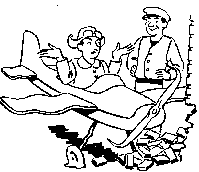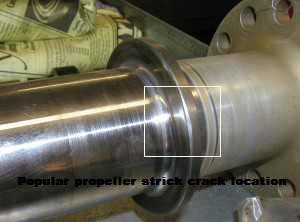If there is not enough aggravation and expense in your life, try having a prop-strike.  A pilot’s first verbal response to unstraightening a prop blade is probably not printable here.  The second response upon learning how long it will take to repair and how much it will cost is also unprintable here.  Suffice to say this sort of accident is an example of where a little damage goes a long way to make life miserable.
Prop strikes are part and parcel of more serious accidents that often involve other airframe damage, but for now let’s discuss the singular prop-strike situation where only the blades are bent.  It is uncommon knowledge among pilots that this type of accident is a very common occurrence.  I have handled hundreds of prop-strike claims over the years.  They often happen while taxiing and involve all levels of pilot experience ranging from students through ATP’s.
Taxiway lights, signs, potholes, unpaved surfaces, orange safety cones, and varied airport detritus await the unwary pilot and his prop.  Strikes can also occur by firm arrivals on the nose gear during landing and you can even have an in-flight prop strike if you hit a bird.  Both the bird and the prop often lose.
 You are looking at the tips of your newly bent prop and saying, “Hmmm, that doesn’t look too bad.”  Should be up and running in no time, right?  Then you hear the mechanic’s magic words:  “This will require an engine sudden stoppage inspection.”  Basically, this is open-heart surgery on your engine to make sure that the load of the prop strike did not cause damage to any vulnerable engine components such as the crankshaft.  The engine will be removed from the plane, disassembled, and inspected according to factory requirements.  Even if the engine did not come to a complete stop during the prop strike, an inspection is still required if the blades sustained damage.
You are looking at the tips of your newly bent prop and saying, “Hmmm, that doesn’t look too bad.”  Should be up and running in no time, right?  Then you hear the mechanic’s magic words:  “This will require an engine sudden stoppage inspection.”  Basically, this is open-heart surgery on your engine to make sure that the load of the prop strike did not cause damage to any vulnerable engine components such as the crankshaft.  The engine will be removed from the plane, disassembled, and inspected according to factory requirements.  Even if the engine did not come to a complete stop during the prop strike, an inspection is still required if the blades sustained damage.
There is good news and bad news.  The good news is that this sort of damage is usually covered under your insurance policy.  The bad news is that repairs may ground your aircraft for up to a month or even longer.  The extended bad news is that even with insurance, you may be facing some out-of-pocket expenses.  If you are a renter, you will likely have to pay for the FBO’s insurance deductible.  If you own the aircraft, besides the deductible, there may be some additional engine costs not covered by insurance.
While the insurance company will pay for engine damage that is a direct result of the prop-strike, it is common to open up an engine, especially higher time ones, and find worn parts or other items that require correction, but have nothing do with the accident.  The owner is responsible for those costs and it can get pricey on a tired engine.  Going back to the good news, the owner may take the money that the insurance company would normally allocate for the engine inspection and apply it towards the cost of an overhaul with the owner paying the balance.
 The entire cost to replace a prop and do an engine inspection runs about $15,000 give or take a few thousand, depending on the aircraft, and does not include the costs for any damage that may be discovered.  In those cases where the strike causes engine damage it is usually found on the crankshaft, which can become bent or cracked especially near the front flange.  This makes sense since the crank attaches directly to the prop hub in most piston aircraft thus making it next in line when it comes to taking the brunt of the transmitted load.
The entire cost to replace a prop and do an engine inspection runs about $15,000 give or take a few thousand, depending on the aircraft, and does not include the costs for any damage that may be discovered.  In those cases where the strike causes engine damage it is usually found on the crankshaft, which can become bent or cracked especially near the front flange.  This makes sense since the crank attaches directly to the prop hub in most piston aircraft thus making it next in line when it comes to taking the brunt of the transmitted load.
It wasn’t all that long ago that mechanics had a lot of discretion as to whether an engine inspection was even necessary after a prop strike.  Product liability concerns of the engine manufacturers took away that discretion and engine accessory manufacturers are now following their lead by mandating inspections or overhauls of prop governors, vacuum pumps, and magnetos because of concern for transmitted loads from a prop strike.  The insurance company may or may not pay for these added inspections depending on the policy wording or may apply what is called a “betterment pro-ration” based on time in service of the old part.  In essence, the owner pays for the extra time in service gained as result of getting a new or overhauled component.  No such thing as a free lunch or vacuum pump.”
Here are some prop tips (if you will excuse the pun).  During preflight be sure that the nose strut and front tire are properly inflated to provide maximum prop clearance.  While taxiing, actively scan for obstructions and potholes in your path.  Even a standing puddle of water is prop-strike potential as it may be hiding a hole or depression.  Unpaved surfaces and soft-field airstrips can be problematic for nose wheel aircraft.  Your chances for a prop strike on these surfaces go up dramatically if they are soft, bumpy, or not properly maintained.  Keep the weight off the nose gear and taxi very slowly while on such surfaces.  Lastly, regardless of the runway surface, land on the main wheels and don’t let the nose gear slam to the ground.
 Just as a little damage can cause a lot of aggravation, it only takes a minor investment of care and caution on the part of a pilot to not become a member of the already crowded “Bent Prop” club.  Don’t let a single strike take you out of the game.
Just as a little damage can cause a lot of aggravation, it only takes a minor investment of care and caution on the part of a pilot to not become a member of the already crowded “Bent Prop” club.  Don’t let a single strike take you out of the game.
Editor’s Note: This article was written by Ken Steiner prior to his retirement from the United States Aircraft Insurance Group as a Vice-President and Claims Manager. During his career, Ken investigated thousands of aircraft accidents involving small planes, crop dusters, helicopters, corporate aircraft, and airliners. He has been on-site at over 100 fatal aircraft accident investigations. He is currently an Aviation Investigative Consultant and is also a Pilot and Tactical Flight Officer for the San Mateo County Sheriff’s Air Support Unit. He owns a Cessna 182 based at San Carlos and holds ATP and CFI certificates with over 5000 flying hours.



